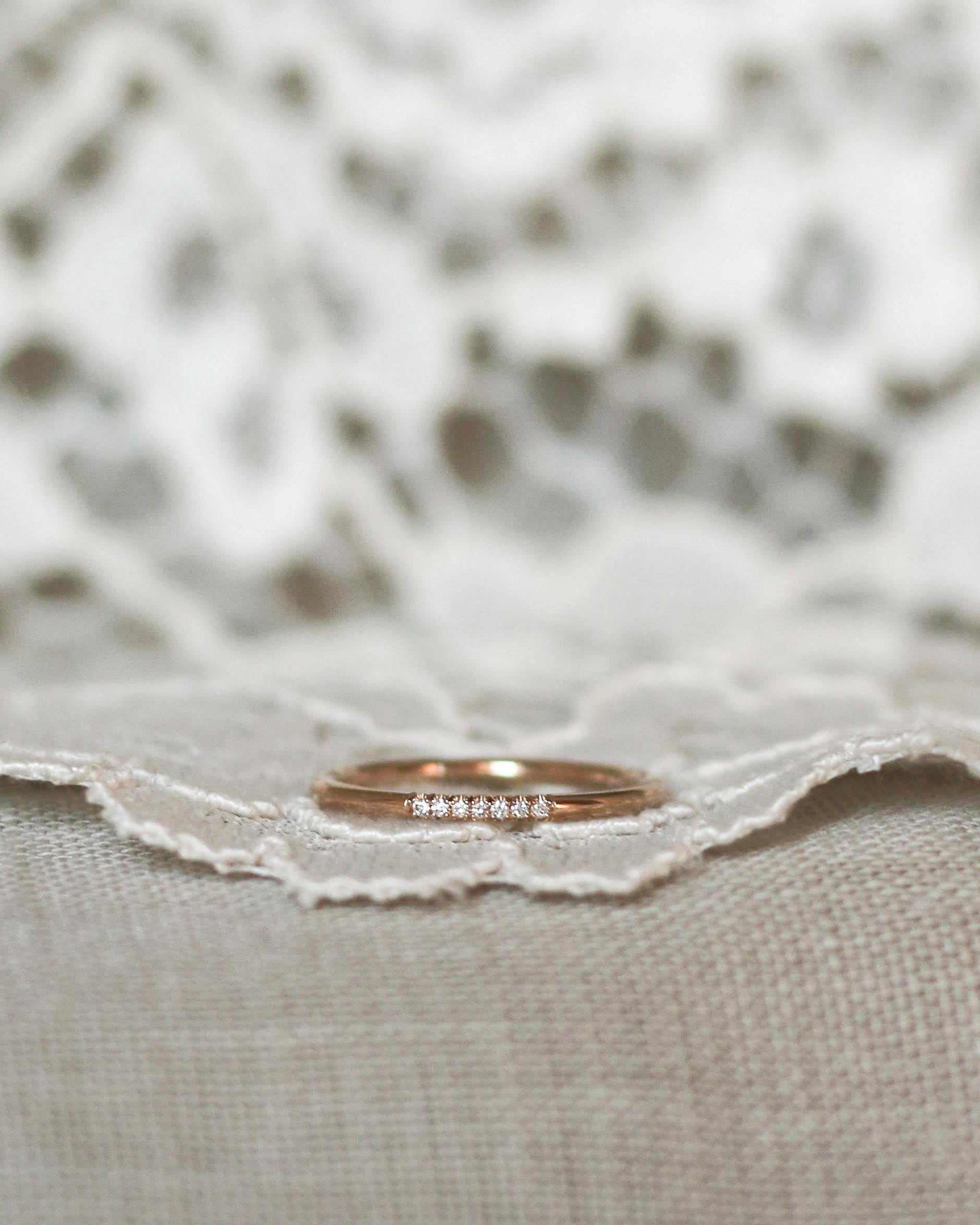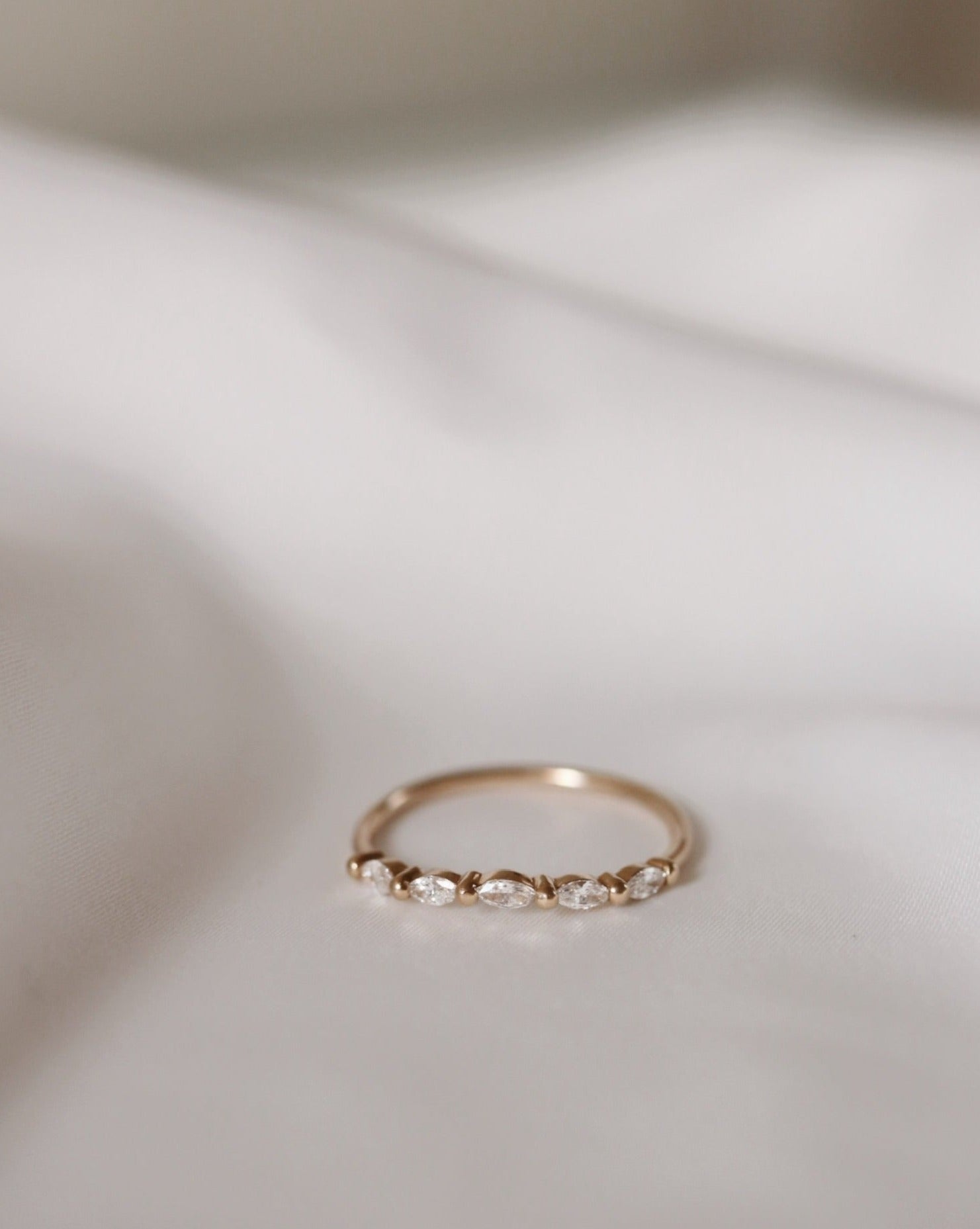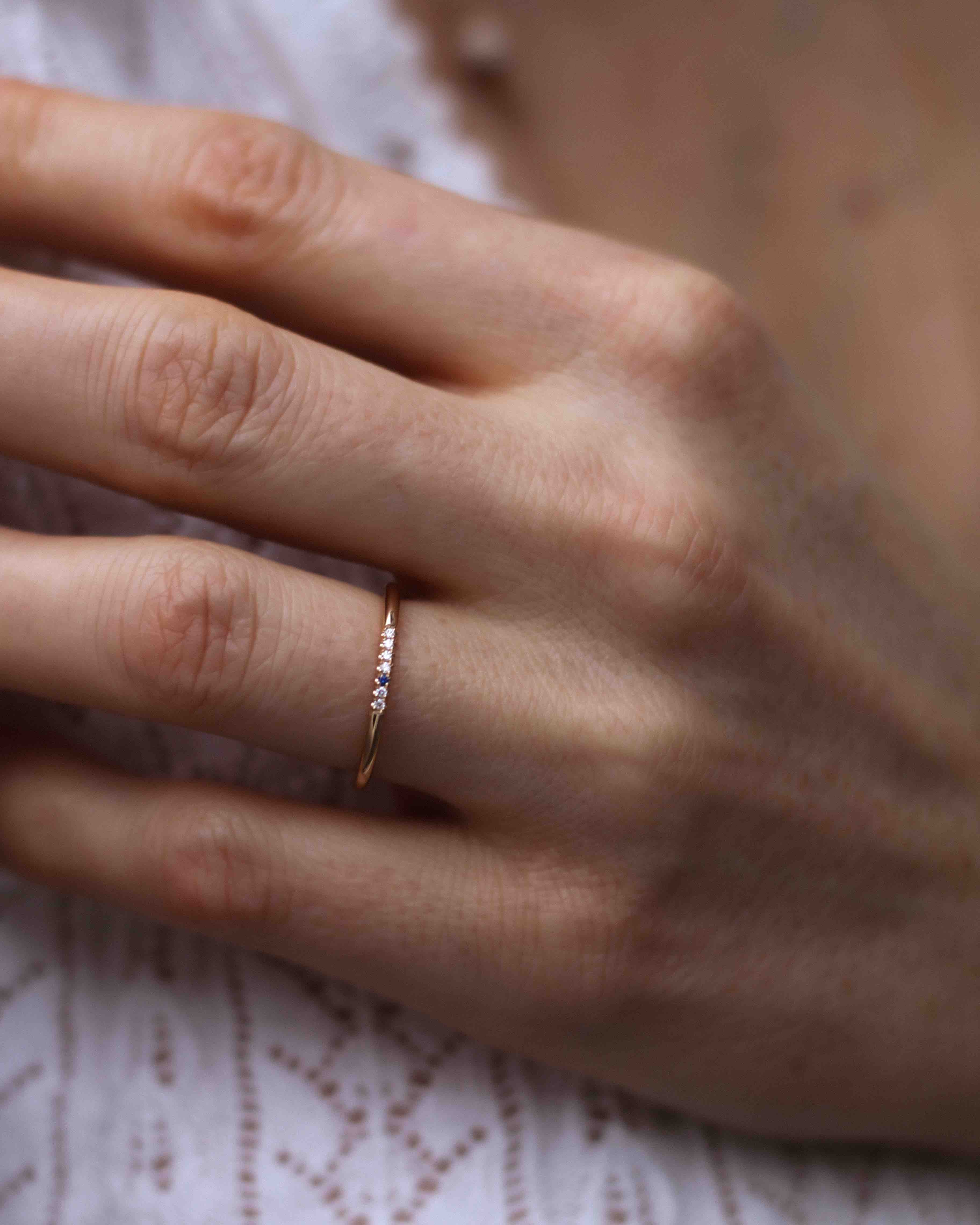How do you choose the right diamond based on your budget and taste? In this article I go through the four C's in a simple way, and then I give you my best tips for choosing just the right diamond for you. I myself am no exception - I also love diamonds. We're getting started! Written by: Cecilia Kores
First of all - why does everyone love diamonds?
Because it is unique! The diamond differs from other precious stones in three main ways:
First: the diamond sparkles through everything
Unlike other gemstones in my jewelry collection, the diamond sparkles through everything - even if it gets dirty!
The white topaz, the clear rock crystal and the bright morganite, on the other hand, are a must cleaned and maintained quite often to really shine. Those of you who have a ring with a morganite may have noticed that it requires its ultrasound bath every now and then! (A simple ultrasound bath is available at Clas Ohlson for around SEK 600, tip!)
Second: diamanten is extremely durable
The diamond is extremely durable - I rarely worry much about my stone wearing, scratching, or tarnishing whatever I take it on for adventures.
It is not unbreakable - if you get a hard blow from just the wrong angle, your stone can split in half - so preferably do not hit it with a hammer . But in general, the diamond is the most durable gemstone you can have in a piece of jewelry!
Third: ddiamond fits almost all jewelry
As a bonus, we have the fact that the diamond fits in almost all jewelry - because you can cut diamonds very large and very small! I have used diamonds that are 0.8mm in some mumbai jewelry - that equates to 0.0005 CT!
In addition, the diamond will be beautiful regardless of the shape in which it is cut. You can get a round diamond (brilliant), triangular (trilliant), heart-shaped, drop-shaped - you name it!

Solitaire rings with classic white diamonds and unique chocolate diamonds. Low set solitaire ring on the far right, the rest have a high setting. All rings Mumbaistockholm
You can compare with, for example, a morganite or an aquamarine that is rarely cut smaller than 3 mm in diameter. You can rarely use morganite as just a small detail in a piece of jewelry - the morganite will often become the star!The diamond, on the other hand, can be brilliantly cut and sprinkled on as accents to really make the piece sparkle - so the diamond doesn't have to be the main feature.
I myself often use diamonds as accent stones when I design to e.g. bring out the beautiful color in a gemstone - then I might decorate with small diamonds around a large tourmaline, to bring out the beautiful green color in the tourmaline!
In this way, the diamond is such an incredibly versatile gemstone, and for those of us who love gemstone jewelry, it's hard not to love the diamond!
Diamantens fyra C
You've probably heard of the four C's of the diamond. Otherwise, it's among the first things you'll come across when you start reading about diamonds - because it's the four C's that determine not only the diamond's beauty (on paper) - but also the price. And the price, you will notice - differs a lot between different diamonds!
The four C's of the diamond are thankfully a fairly simple system - and thanks to the fact that it has been recognized and used in the diamond trade all over the world, it's worth spending some time learning it! (For example, by reading the tricks in this article.)
Once you have learned to understand the four C's, you will easily be able to tell the difference between two white diamonds that at first glance look exactly the same. You will also know when you can ignore the well-meaning recommendations of others and know exactly when you have chosen the right diamond for you!
Briefly about the background to the four C's
The four Cs of the diamond were launched in 1953 by the famous diamond grading institute GIA - Gemmology Institute of America.
The aim was simply to create once and for all a common vocabulary for the four factors that distinguish white diamonds: the color, the clarity, the cut and the size (carat).
The system that GIA created, "the 4Cs of Diamond Quality" is still today the universal method for assessing the quality of any diamond, anywhere in the world. The goal, which in the 1950s was to facilitate a global trade in diamonds through one and the same quality system, one must say was really achieved!
So, let's go through the four C's one by one!

Diamonds in different cuts - here drop-shaped (also called pear-shaped) and brilliant-cut diamonds in different sizes. All jewelery Mumbaistockholm
Carat - the first of the four Cs
Carat is perhaps the most well-known characteristic of a diamond, but few fully understand the concept.
Carat with C is a weight where 1 CT corresponds to 0.2 grams. This means that a 5 CT diamond ( only weighs 1 gram!
The carat weight is printed 0.25 CT, 0.50 CT, 1.0 CT, 1.5 CT, etc.
What many people misunderstand when it comes to carat is that they think it indicates how big the diamondlooks. But that's not quite right!
Two different diamonds can have exactly the same CT weight, but look completely different sizes if they are cut in two different shapes.
For example, a 5 CT diamond that is brilliant cut (round) has the same diameter as a thumb nail: about 11 millimeters. Whereas a 5 CT diamond that is princess-cut (square) is only 9.5 millimeters in diameter. More like an index finger nail!
Since the corners have been cut off on the round stone, it always weighs less (=lower CT) than a square stone of the same diameter!
Since the price is determined by the CT and not the diameter, it is cheaper to buy a round stone than a square one, if you want a stone that looks as big as possible.
An additional parameter that affects how big a particular diamond looks also has to do with the quality of the cut (how well balanced the angles and proportions are). A brilliant-cut diamond with a "Poor" cut grade (the lowest cut grade in a GIA certificate) may appear smaller because it is cut deeper than a brilliant with the grinding grade "Excellent", which is shallower and has a larger diameter! Even if both have the same CT, that is.
Color - the second of the four C's
In fact, this refers to the absence of color.
A chemically perfect diamond has no color at all, like a drop of water.
One such is designated by the letter D in the certificate - it is completely colourless. Then the letters follow the alphabet all the way down to Z, which is the least valuable with a noticeable yellow or brown tint. Then we are not talking about the beautiful champagne or chocolate diamonds, but about a slightly discolored diamond, which "should" be white but has acquired a yellow or brown discolored tone.
If a diamond is so far from colorless that it passes Z in the alphabet - then it reverses and the diamond is instead called fancy colored diamonds - which means nice colored diamonds! Then the price goes up again! (Those certificates can then say fancy pink or fancy yellow, for example.) Here we find, for example, the beautiful champagne and chocolate diamonds!
(That's why it can be very exciting for a dealer who bought a lot of uncertified stones and submits them to GIA to get a certificate - then they cross their fingers that they pass the "discoloration scale" and instead are considered fancy colored, because the dealer can then sell them more expensive!)
But why does the color scale go from D to Z? Well, because before the GIA created its system, there had been other methods to describe the color of diamonds, such as e.g. A, B, C or Roman numerals. The creators of the GIA system wanted to start over, and so they simply skipped the first letters of the alphabet and started on D, for the most perfectly colorless diamond!
The color scale for white diamonds according to GIA
D, E, F are considered colorless. These are the most expensive diamonds.
G, H, J are almost colorless.
K, L, M are called faint color.
N, O, P, Q, R have a very light color, i.e. a slightly visible shade.
S all the way down to Z has a light color, i.e. a noticeable brown or yellow shade.
Many of these color differences are so subtle that they are invisible to the untrained eye; but the differences become big for the diamond quality and the price.
After Z, they are called fancy diamonds - and then the price scale turns and they can actually be as expensive as you want! But most fancy diamonds you see in stores are white discolored diamonds that have been irradiated to become pink, blue or green - and are sold quite cheaply!
Wesselton and Top Wesselton then?
You may have heard the words River, Top Wesselton and Wesselton mentioned in the diamond context?
It is the old Swedish name for the color of white diamonds. Back then, diamonds were described by how they looked or by the place they were found.
“River” refers to the fact that the diamonds are completely colorless like water, but it is also said to be because they were found in running water. Wesselton and Top Wesselton come from the fact that a certain type of diamond used to be found in the Wesselton mine. Their correspondence to the letter designation follows below.
River: D and E (highest quality)
Top Wesselton: F and G
Wesselton: H
Top Crystal: I
Crystal: J
Top Cape: K, L
Cape: M, N
The name "Cape" comes from the bright yellow diamonds found in a mine near Cape Town.

Antique diamonds often have a color described as Top Cape or Cape - so between K-N on the color scale! If you see them next to a modern cut D or E diamond, you can see a light tone in the diamond, which many of us find charming! Here an antique diamond ring with three diamonds and a solitaire ring with an antique diamond, Mumbaistockholm
Clarity - the third of the four C's
Diamond clarity refers to how flawless the crystal itself is—whether the gemstone has any inclusions or blemishes.
Grading is based on the absence of inclusions and blemishes, where the diamond that is completely free of these blemishes is considered flawless.
But the vast majority of diamonds - even really high quality ones - have at least some flaws. It comes naturally from the fact that natural diamonds are formed from coal that has been exposed to high heat and enormous pressure deep down in the earth's crust. It is rarely all peace and quiet when the diamond crystal grows! Therefore, it often results in a variety of internal and external cracks in the crystal - the internal ones are called "inclusions" and the external ones are called "spots".
Each fully cut diamond is then given a clarity grade based on the number and visibility of these impurities as well as where they sit in the gemstone. Evaluating diamond clarity simply means looking at the number, size and location of inclusions and blemishes - and how they affect the overall appearance of the gemstone.
Keep in mind that the clarity scale below is based on a 10x magnifying glass - so with your naked eyes you can only see the inclusions found in stones from grade I and below!
The GIA diamond clarity scale
FL Flawless: no visible inclusions or blemishes can be discerned with 10x magnification
IF Internally Flawless: no visible inclusions but however some blemishes on the surface can be seen at 10x magnification
VVS1, VVS2 Very, very slightly included: inclusions so small that it is difficult for a skilled grader to see them (still at 10x magnification)
VS1, VS2 Very Slightly Included: small inclusions can be seen with effort by a skilled grader (with 10x magnification)
SI1, SI2 Slightly included: visible inclusions with 10x magnification
I1, I2, I3 Included: visible inclusions that can affect the appearance of the diamond to the naked eye, such as its transparency and brilliance
The fewer inclusions and blemishes, the higher the clarity of the diamond - and the higher the price.
Very few diamonds are perfectly clean and clear - so the trade-off comes down to what imperfections you can accept!
Many inclusions and blemishes are too small to be seen by anyone other than a trained diamond grader looking at it under magnification. To the naked eye, a VS1 and SI2 diamond look exactly the same - but you will pay completely different prices for them!
To the naked eye, a VS1 and SI2 diamond look exactly the same - but you will pay completely different prices for them!
So here's an industry tip: among jewellers, actually inclusions are often something you choose to compromise on, since most are invisible anyway - especially in a set piece of jewelry! So many choose SI clarity and go for a larger CT or higher color instead!

Diamonds in white gold jewelry become extra white - if they have a high color! Otherwise, they can look even more discolored or yellowed. Jewelery MumbaiStockholm
The grind - the fourth of the four C's
Diamonds are known for their ability to reflect light and sparkle so intensely.
We often think of a diamond cut as a shape (round, princess, oval, marquise, drop), but what a diamond cut really means is how well a diamond's facets interact with light - that's what the grader looks at.
You also look at the diameter in relation to the depth - so the grinder has not taken a shortcut and cut a very shallow diamond (= reflects light poorly) just to get a larger diameter, for example.
Of the four Cs of the diamond, it is usually said that the cut is the most complex and technically the most difficult to analyze. The craft skills of the sander greatly influence the quality of the sanding.
GIA grades brilliant-cut round diamonds, which are the most common, into five grades: Excellent, Very Good, Good, Fair, and Poor.
Many jewelers believe that the cut is the most important of the four Cs and that it is what determines how beautiful a diamond is - because it is the cut that most affects the light reflection and sparkle emitted from the stone.
Many jewelers believe that the cut is the most important of the four C's and that it is what determines how beautiful a diamond is

Charms for diamond necklaces. These with quality TWVS, or Top Wesselton VS. All jewelery Mumbaistockholm
..so which diamond should I choose?
Lovely! Now that you've made it all the way down here, you hopefully feel that you have a much better sense of and a greater understanding of that mysterious thing called the "Four C's of the Diamond".
It's really not very difficult at all!
What you need to decide is which of the four qualities you think is most important. There are many of us who love large diamonds - and for us the degree of clarity is not the most important thing at all. Since you can't see the difference between SI and VS with the naked eye, but you can see the difference between a 0.40 CT and a 0.60 CT with the naked eye, we are ready to go down in clarity. However, we may want a very white stone - and then we may not want to go below F or G in color. We might also want a fantastically shimmering stone - and then we look for a stone with at least Very Good in grinding.
More on this in the next article - where I'll give you the jeweler's best tips for choosing the right diamond, now that you know the four C's!
Good luck in your diamond hunt!
We are happy to help you. Email us at showroom@mumbaistockholm.com or online@mumbaistockholm.com, or call us, and you will receive personal guidance and help!
XX
Cecilia
Are you even more curious about diamonds? Feel free to listen to Smickespodden's Episode 24. The big episode about diamonds below or click here !
Subscribe to Smickespodden on Spotify, Acast and iTunes.


































































Leave a comment